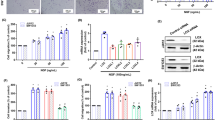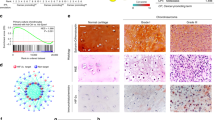Abstract
Chondrosarcomas represent the second most frequent class of primary skeletal malignancies. This tumor type is highly resistant to radiation therapy and currently available chemotherapies, thereby limiting treatment choice to surgical resection. Identifying the mechanisms responsible for chondrosarcoma cell proliferation is therefore crucial for the development of new treatment strategies. Here, we demonstrate a significant reduction in rat chondrosarcoma cell proliferation following treatment with pharmacological inhibitors (SB202190 and PD169316) of p38 mitogen-activated protein (MAP) kinases. In an attempt to dissect possible mechanisms, we investigated the effect of p38 inhibition on promoter activity of cell-cycle genes. Surprisingly, p38 inhibition resulted in upregulation of the activities of all three D-type cyclin promoters. In addition, p38 inhibitors induced increased transcription of the cell-cycle inhibitor p21waf1/cip1. As expected, promoter activity of the cyclin A gene, which lies downstream of D-type cyclins and p21 in cell-cycle progression, was strongly reduced by p38 inhibitors. These effects were independent of a cyclic AMP response element and conferred by the proximal 150 nucleotides of the cyclin A promoter. Decreased transcription was accompanied by greatly reduced cyclin A protein levels upon p38 inhibition. These observations indicate complex regulation of chondrosarcoma cell-cycle progression by p38 signaling, and suggest that components of p38 MAP kinase pathways may be effective targets in the treatment of these tumors.
This is a preview of subscription content, access via your institution
Access options
Subscribe to this journal
Receive 50 print issues and online access
$259.00 per year
only $5.18 per issue
Buy this article
- Purchase on Springer Link
- Instant access to full article PDF
Prices may be subject to local taxes which are calculated during checkout




Similar content being viewed by others
References
Aigner T . (2002). Virchows Arch., 441, 219–230.
Albanese C, Johnson J, Watanabe G, Eklund N, Vu D, Arnold A and Pestell RG . (1995). J. Biol. Chem., 270, 23589–23597.
Alderton F, Humphrey PP and Sellers LA . (2001). Mol. Pharmacol., 59, 1119–1128.
Ambrosino C and Nebreda AR . (2001). Biol. Cell., 93, 47–51.
Beier F, Ali Z, Mok D, Taylor AC, Leask T, Albanese C, Pestell RG and LuValle P . (2001). Mol. Biol. Cell., 12, 3852–3863.
Beier F, Lee RJ, Taylor AC, Pestell RG and LuValle P . (1999a). Proc. Natl. Acad. Sci. USA, 96, 1433–1438.
Beier F and LuValle P . (2002). Mol. Endocrinol., 16, 2163–2173.
Beier F, Taylor AC and LuValle P . (1999b). J. Biol. Chem., 274, 30273–30279.
Beier F, Taylor AC and LuValle P . (2000). J. Biol. Chem., 275, 12948–12953.
Brooks AR, Shiffman D, Chan CS, Brooks EE and Milner PG . (1996). J. Biol. Chem., 271, 9090–9099.
Carnero A . (2002). Br. J. Cancer, 87, 129–133.
Casanovas O, Miro F, Estanyol JM, Itarte E, Agell N and Bachs O . (2000). J. Biol. Chem., 275, 35091–35097.
Crawley JB, Rawlinson L, Lali FV, Page TH, Saklatvala J and Foxwell BM . (1997). J. Biol. Chem., 272, 15023–15027.
Diehl NL, Enslen H, Fortner KA, Merritt C, Stetson N, Charland C, Flavell RA, Davis RJ and Rincón M . (2000). J. Exp. Med., 191, 321–334.
Dulic V, Drullinger LF, Lees E, Reed SI and Stein GH . (1993). Proc. Natl. Acad. Sci. USA, 90, 11034–11038.
Greenberg AK, Basu S, Hu J, Yie TA, Tchou-Wong KM, Rom WN and Lee TC . (2002). Am. J. Respir. Cell Mol. Biol., 26, 558–564.
Juretic N, Santibanez JF, Hurtado C and Martinez J . (2001). J. Cell. Biochem., 83, 92–98.
Kakonen SM, Selander KS, Chirgwin JM, Yin JJ, Burns S, Rankin WA, Grubbs BG, Dallas M, Cui Y and Guise TA . (2002). J. Biol. Chem., 277, 24571–24578.
Kiess M, Gill RM and Hamel PA . (1995). Oncogene, 10, 159–166.
Maher P . (1999). J. Biol. Chem., 274, 17491–17498.
Meyyappan M, Wong H, Hull C and Riabowol KT . (1998). Mol. Cell. Biol., 18, 3163–3172.
Mollano AV, Martin JA and Buckwalter JA . (2002). Iowa Orthop. J., 22, 1–7.
Mukhopadhyay K, Lefebvre V, Zhou G, Garofalo S, Kimura JH and de Crombrugghe B . (1995). J. Biol. Chem., 270, 27711–27719.
Nakamura T, Okuyama S, Okamoto S, Nakajima T, Sekiya S and Oda K . (1995). Exp. Cell Res., 216, 422–430.
Neve RM, Holbro T and Hynes NE . (2002). Oncogene, 21, 4567–4576.
Peters G . (1994). J. Cell Sci. Suppl., 18, 89–96.
Pring ME, Weber KL, Unni KK and Sim FH . (2001). J. Bone Joint Surg. Am., 83-A, 1630–1642.
Puri PL, Wu Z, Zhang P, Wood LD, Bhakta KS, Han J, Feramisco JR, Karin M and Wang JY . (2000). Genes Dev., 14, 574–584.
Recio JA and Merlino G . (2002). Oncogene, 21, 1000–1008.
Royuela M, Arenas MI, Bethencourt FR, Sanchez-Chapado M, Fraile B and Paniagua R . (2002). Hum. Pathol., 33, 299–306.
Shemirani B and Crowe DL . (2002). Oral Oncol., 38, 251–257.
Shimizu M, Nomura Y, Suzuki H, Ichikawa E, Takeuchi A, Suzuki M, Nakamura T, Nakajima T and Oda K . (1998). Exp. Cell Res., 239, 93–103.
Smalley KS and Eisen TG . (2002). Melanoma Res., 12, 187–192.
Sylvester AM, Chen D, Krasinski K and Andres V . (1998). J. Clin. Invest., 101, 940–948.
Wang XZ and Ron D . (1996). Science, 272, 1347–1349.
Weinberg RA . (1995). Cell, 81, 323–330.
Yan GZ and Ziff EB . (1995). J. Neurosci., 15, 6200–6212.
Yosimichi G, Nakanishi T, Nishida T, Hattori T, Takano-Yamamoto T and Takigawa M . (2001). Eur. J. Biochem., 268, 6058–6065.
Zhao M, Liu Y, Bao M, Kato Y, Han J and Eaton JW . (2002). Arch. Biochem. Biophys., 400, 199–207.
Zhu T and Lobie PE . (2000). J. Biol. Chem., 275, 2103–2114.
Acknowledgements
We are grateful to Drs K Oda, D Shiffman, RG Pestell, and B Vogelstein for the generous gift of plasmids. This work was supported by funds from the Canadian Institutes of Health Research, the Canadian Arthritis Network, and the Department of Physiology, University of Western Ontario to FB.
Author information
Authors and Affiliations
Corresponding author
Rights and permissions
About this article
Cite this article
Halawani, D., Mondeh, R., Stanton, LA. et al. p38 MAP kinase signaling is necessary for rat chondrosarcoma cell proliferation. Oncogene 23, 3726–3731 (2004). https://doi.org/10.1038/sj.onc.1207422
Received:
Revised:
Accepted:
Published:
Issue Date:
DOI: https://doi.org/10.1038/sj.onc.1207422
Keywords
This article is cited by
-
p38 differentially regulates ERK, p21, and mitogenic signalling in two pancreatic carcinoma cell lines
Journal of Cell Communication and Signaling (2018)
-
Genetic alterations in chondrosarcomas – keys to targeted therapies?
Cellular Oncology (2014)
-
Correlation between p38 mitogen-activated protein kinase and human telomerase reverse transcriptase in sarcomas
Journal of Experimental & Clinical Cancer Research (2012)
-
Differential p38-dependent signalling in response to cellular stress and mitogenic stimulation in fibroblasts
Cell Communication and Signaling (2012)
-
Signal integration by JNK and p38 MAPK pathways in cancer development
Nature Reviews Cancer (2009)



